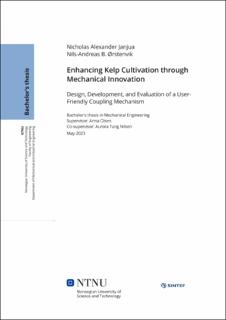| dc.contributor.advisor | Olsen, Anna | |
| dc.contributor.advisor | Nilsen, Aurora Tung | |
| dc.contributor.author | Janjua, Nicholas Alexander | |
| dc.contributor.author | Ørstenvik, Nils-Andreas B. | |
| dc.date.accessioned | 2023-08-14T17:19:31Z | |
| dc.date.available | 2023-08-14T17:19:31Z | |
| dc.date.issued | 2023 | |
| dc.identifier | no.ntnu:inspera:142733160:149806704 | |
| dc.identifier.uri | https://hdl.handle.net/11250/3083933 | |
| dc.description.abstract | Kultivering av tare har hatt en enorm økning i interesse det siste tiåret. Potensielle bruksområder som CO2-fangst, material- og matproduksjon gjør tare til en av de mest aktuelle marine ressursene vi har for øyeblikket. Det er derimot forsket lite på optimalisering av kultiveringsanleggene. Målet med denne oppgaven er derfor å gi innsikt i prossessen bak utviklingen av en klips-mekanisme for bruk innen tareoppdrett. Oppgaven er en del av et prosjekt som ble gjennomført i samarbeid med SINTEF Ocean og beskriver utviklingen fra markedsmulighet til funksjonell prototype.
For å få bedre forståelse av tareindustrien og dagens situasjon, utforsket vi de vanligste kultiveringsmetodene og identifiserte de viktigste momentene for å maksimere potensialet. Dette ga verdifull innsikt i de tekniske kravene, samt behovene til sluttbrukeren.
For å styre design- og utviklingsprossesen i samsvar med de overordnede prosjektmålene, ble det implementert en systematisk tilnærming. Denne bygger på allerede godt etablerte teorier og modeller om produktutvikling, og tar i bruk flere forskjellige metoder, som er tilpasset til den aktuelle fasen av prosjektet. I hovedsak ble det brukt metoder som brukerfokusert design, hyppig idégenerering, prototyping, iterativ utvikling og testing, men det ble også tatt i bruk mer typisk sekvensiell metodikk.
Ved å følge den nevnte metodikken, ble produktet "the KelpClip" utviklet. Denne klipsen er en lovende løsning med tanke på de tekniske kravene og prosjektmålene. | |
| dc.description.abstract | Kelp cultivation has seen a surge in interest over the last decade. Given its potential use in areas
such as CO2 capture, material and food production, it is difficult to overstate its significance. Unfortunately, little research has been done on the subject of optimising facilities for kelp cultivation.
The aim of this thesis is therefore to provide insight into the product development process of a
mechanical clip on device for use in kelp cultivation. The thesis is part of a project in collaboration with SINTEF Ocean, describing the transformation of a market opportunity into a working
prototype.
An examination of global cultivation methods and practices was undertaken to enhance our understanding of the industry’s status quo. This review identified key factors for optimising kelp
cultivation and offered invaluable insights into the technical requirements and user needs.
To navigate the design and development process in line with the project goals, we employed a
systematic approach rooted in established theories and models in the product development field.
The chosen methodology adopted a toolkit of strategies, which were tailored to suit the unique
needs of each development stage. This toolkit encompassed user-centred design, frequent idea
generation, prototyping, iterative development and testing, and also incorporated more traditional,
sequential methods.
By adhering to the methods, the KelpClip eventually emerged as a promising solution, showing
promise for both technical requirements and satisfying the outlined project goals. | |
| dc.language | eng | |
| dc.publisher | NTNU | |
| dc.title | Enhancing Kelp Cultivation through Mechanical Innovation | |
| dc.type | Bachelor thesis | |
